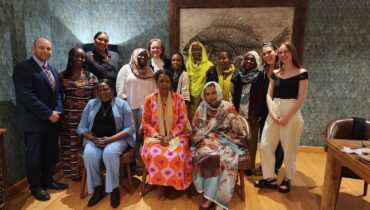By Ambassador Melanne Verveer and Dr. Robert Egnell
Originally posted on Huffington Post here.
The brutality of ISIS, Russia’s aggression in Ukraine and the Ebola epidemic are issues that give us the sense that we are returning to a harsher and more violent world of “realpolitik” than what we have witnessed during the last couple of decades. Decision makers are constantly faced with the difficult task of how to most effectively use resources to maximize national security and enhance international peace. But, when the world is on fire, is there really room to ignore the role of women in peace and security?
The answer is no! Focusing on women, peace and security does not mean shifting focus from “hard” to “soft” issues. Women constitute half the world’s population. Incorporating their perspectives is not merely the right thing to do, it is also the smart and strategic thing to do. Ensuring women’s participation is at the heart of better understanding and dealing with the threats that we face with the right instruments, and in the most effective manner possible. This agenda serves as a critical instrument in the work to prevent armed conflict, create peace where violence has broken out, and support reconciliation and reconstruction processes after war.
At a recent speech at Georgetown University on inclusive security, former U.S. Secretary of State Hillary Rodham Clinton noted that when women participate in peace processes, “overlooked issues such as human rights, individual justice, national reconciliation, and economic renewal are often brought to the forefront.”
The backdrop for these issues is the United Nations Agenda for Women, Peace and Security, which was codified in the landmark Security Council Resolution 1325 (2000), as well as a number of subsequent resolutions that build upon this foundation and lay out steps for implementation. Many countries have already started grappling with these issues by writing National Action Plans on Women, Peace and Security, and by implementing these perspectives within military, diplomatic and development operations.
However, implementation is slow and, in many cases, accompanied by strong resistance and lack of understanding. By building the knowledge and capacity of those designing and implementing national action plans, we can ensure that progress quickens on women, peace and security around the globe. According to Secretary Clinton, we must begin “shifting from saying the right things to doing the right things, putting into action the steps that are necessary not only to protect women and children, but to find ways of utilizing women as makers and keepers of peace.”
We know that women are uniquely and disproportionately affected by armed conflict, climate change and natural disasters. We also know that women are oftentimes marginalized. Accountability for harms suffered – such as sexual violence – is bargained away during negotiations to end hostilities. The same is often true after a peace agreement is signed. Is it really any surprise then that half of all peace agreements fail within the first five years of being adopted?
Policies and practices to protect women during conflict and ensure their participation in the resolution of those conflicts rely on an understanding of women’s roles within society. Ine Eriksen Søreide, Minister of Defence of the Kingdom of Norway, reminds us, “women are not only the victims – they’re also important actors.” Grassroots women are, more often than not, mobilized for peace, but they rarely receive the recognition they deserve from national and international authorities. Their voices do not always carry over into the halls of power.
Focusing on advancing women’s roles in peace and security efforts, including military operations, is not only about women’s rights, but also about increasing operational effectiveness. Missions in Kosovo, Iraq and Afghanistan have clearly demonstrated that military operations often require a gender perspective in order to be effective – whether for intelligence gathering, stabilization mandates, or training and equipping local forces. Jens Stoltenberg, Secretary General of NATO has argued, “integrating gender perspectives into our activities makes us a more modern, ready, and responsive alliance…it allows us to respond better and smarter to the many complex security challenges we face today.” Major General Adrian Foster, Deputy Military Adviser for the United Nations Department of Peacekeeping Operations similarly argues that “gender is no longer an optional-add on; it is an operational necessity.”
The security threats and challenges we face, most often, result from a failure to address the root causes of conflict. The women, peace and security agenda sees a broader scope of security issues, which can help decision makers to recognize and deal with the underlying causes of problems and the instruments needed for dealing with them – preferably before armed conflicts or terror attacks occur. According to Staffan de Mistura, United Nations Special Envoy for Syria, “In no place have I not seen women being major a player in helping…to produce a peaceful solution to a conflict.”
A solid foundation of research and experience shows us that gender equality, women’s participation and the implementation of gender perspectives lead to increased effectiveness in our aspirations for peace, security and human rights – locally, nationally and globally. It is certainly not a “silver bullet”, nor the answer to every problem. However, dealing with the complex security challenges facing our world indeed requires incorporating women into peace and security operations for greater effectiveness.


